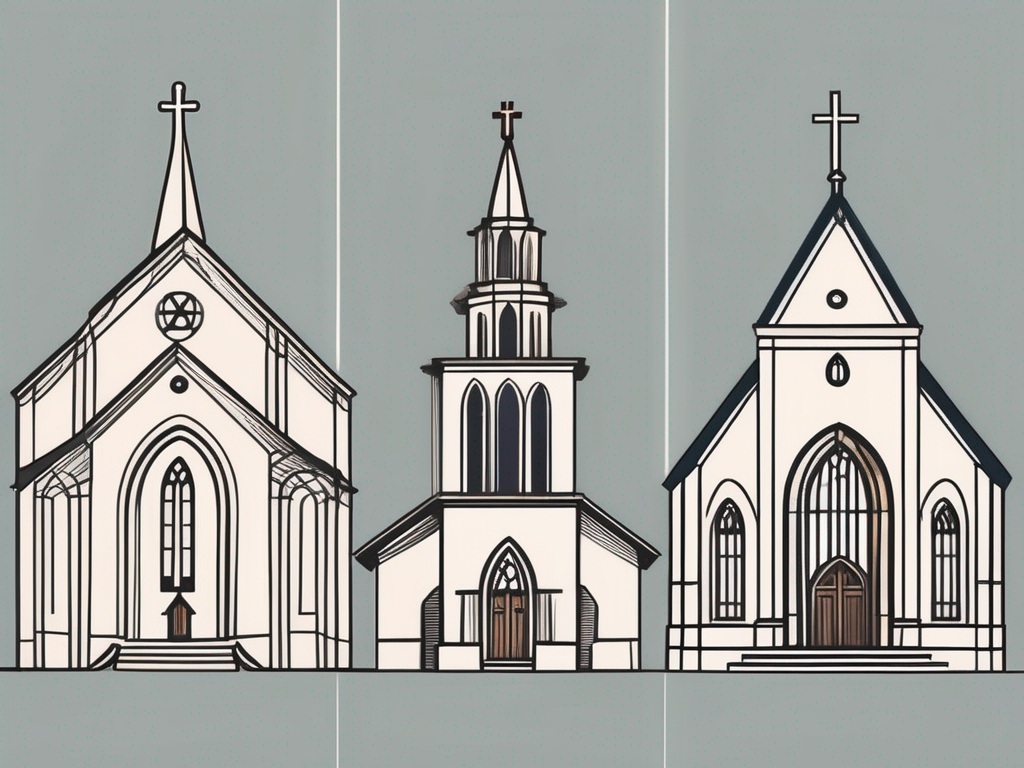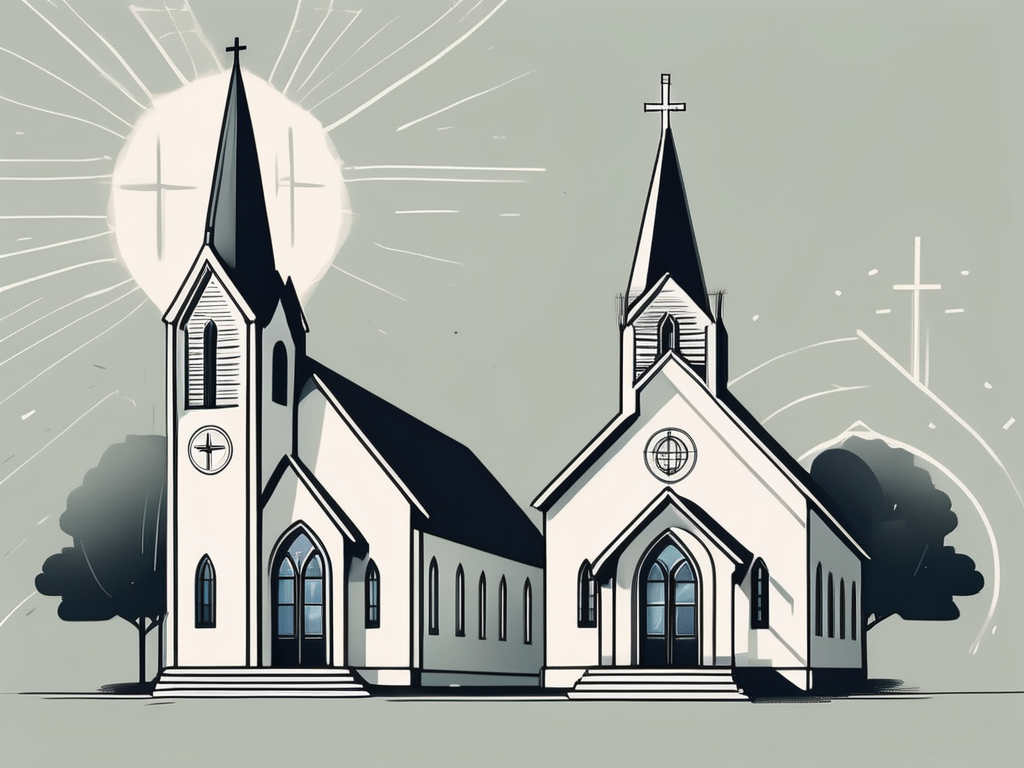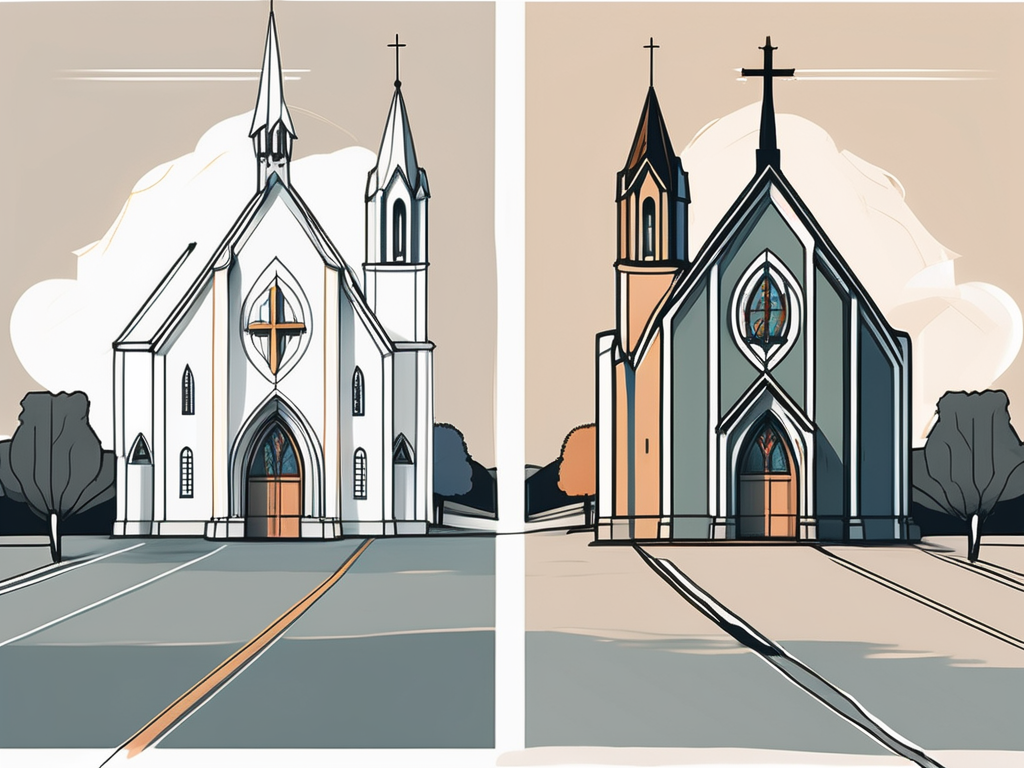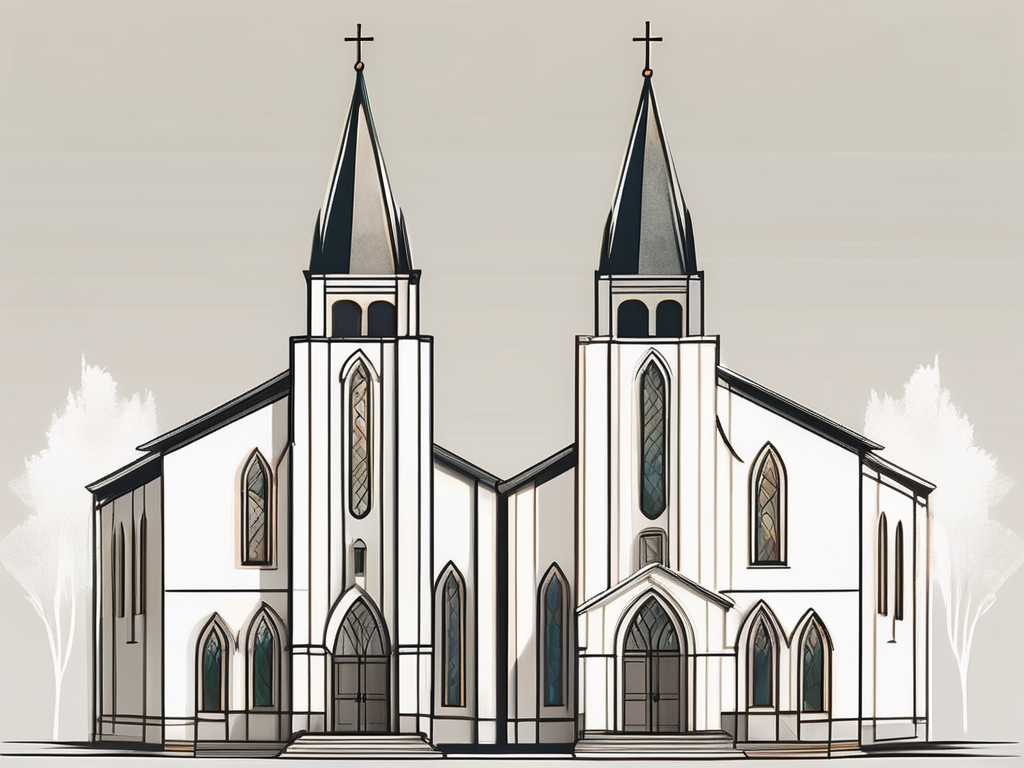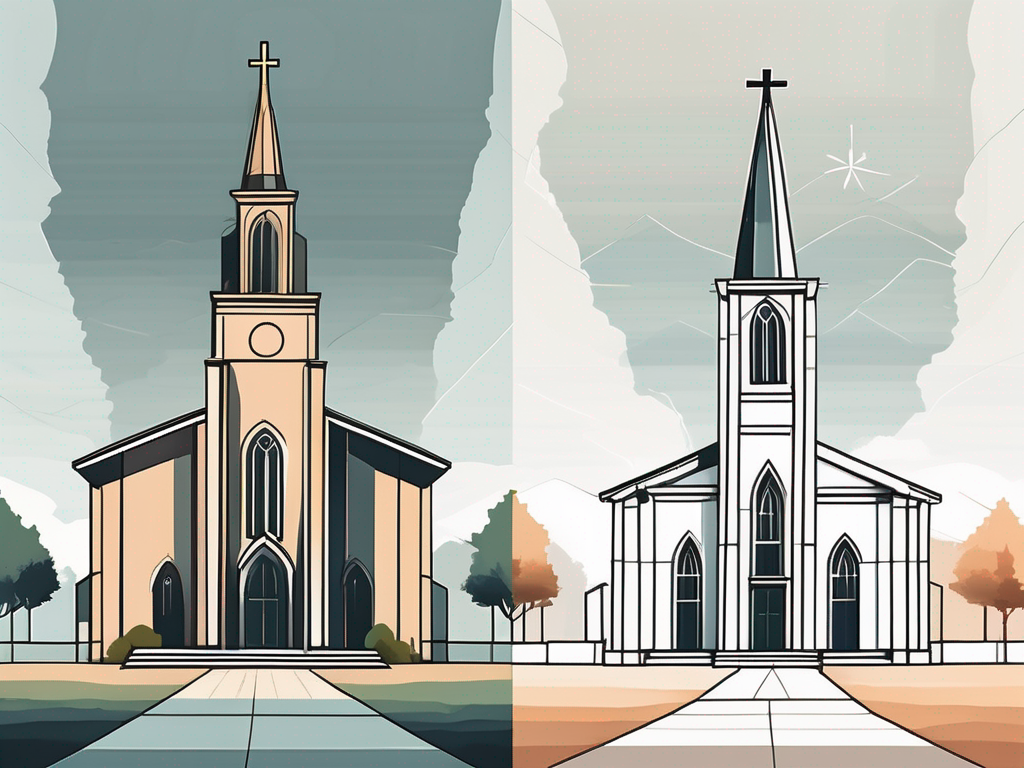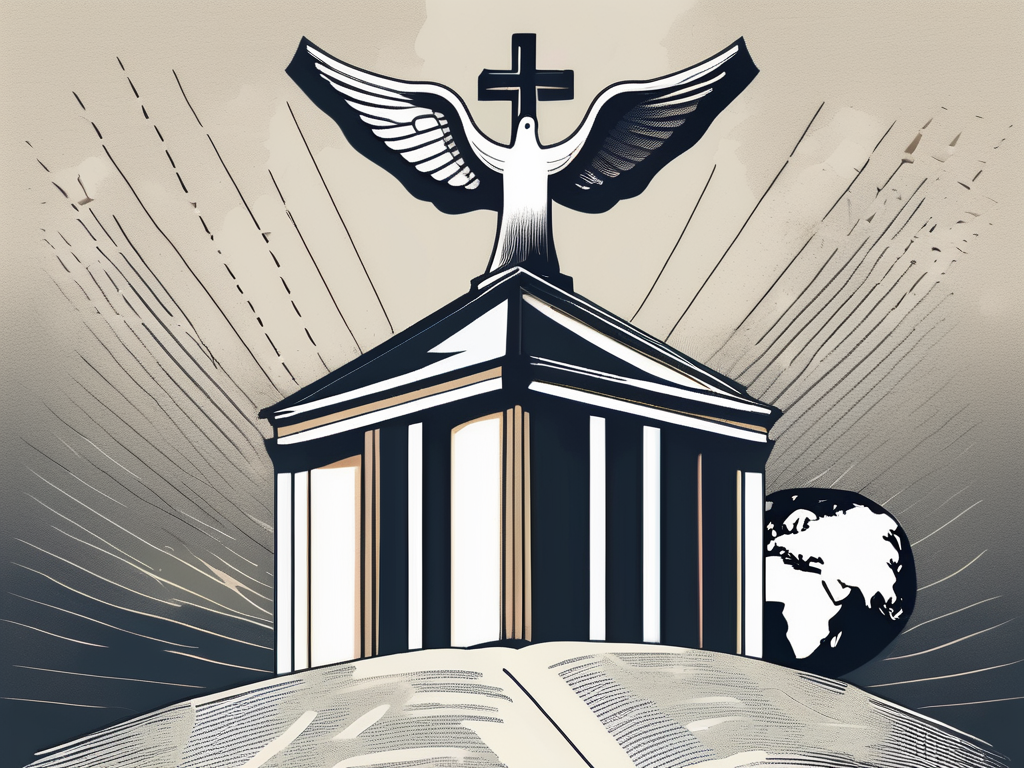In today’s diverse religious landscape, Catholicism and Evangelicalism stand as two prominent branches of Christianity. While both faiths share a common belief in Jesus Christ, they differ in many aspects of doctrine, worship, and church structure. Understanding the similarities and differences between these two traditions can provide a deeper understanding of the Christian faith as a whole.
Exploring the Origins of Catholicism and Evangelicalism
The Birth of Catholicism
Catholicism traces its roots back to the early Christian Church established by Jesus Christ and his apostles. The term “Catholic” comes from the Greek word “katholikos,” meaning “universal.” This name reflects the Church’s belief in its global mission to spread the teachings of Jesus to all people, regardless of nationality or culture.
As the early Christian community grew, it faced challenges and controversies. The Church leaders, known as bishops, sought to maintain unity and orthodoxy in their teachings. They believed that the authority of the Church stemmed directly from the apostles and their successors, the bishops. This concept, known as apostolic succession, became a fundamental belief in Catholicism.
Over the centuries, Catholicism grew into a global institution, with the Pope serving as the spiritual leader and the Vatican as its governing center. The Church places great emphasis on tradition, sacraments, and the authority of the magisterium, which interprets scripture and guides the faithful. This rich tradition and hierarchical structure have helped Catholicism maintain its unity and continuity throughout history.
The Emergence of Evangelicalism
Evangelicalism, on the other hand, represents a more recent development within Christianity. It emerged primarily during the Protestant Reformation in the 16th century, as a response to what some saw as corruption and doctrinal deviations within the Catholic Church. The word “evangelical” derives from the Greek “euangelion,” meaning “good news” or “gospel.”
Evangelicals focus on spreading the message of salvation through faith in Jesus Christ. They emphasize the Bible as the primary authority and believe in personal conversion and a direct relationship with God. This emphasis on individual faith and personal experience sets Evangelicalism apart from other Christian traditions.
Evangelical churches often encourage active evangelism and discipleship. They believe that every Christian has a responsibility to share the good news of Jesus Christ with others. This commitment to spreading the gospel has led to the establishment of numerous missionary organizations and evangelistic movements throughout history.
Furthermore, Evangelicalism has been characterized by its diversity and adaptability. It has given rise to various denominations and movements, each with its own distinct practices and theological emphases. From charismatic and Pentecostal churches to conservative and liberal Evangelical groups, the movement has shown a remarkable ability to adapt to different cultural and social contexts.
In conclusion, both Catholicism and Evangelicalism have rich histories and unique characteristics that have shaped the landscape of Christianity. While Catholicism emphasizes tradition, sacraments, and the authority of the magisterium, Evangelicalism focuses on personal faith, the Bible as the primary authority, and active evangelism. Despite their differences, both traditions continue to play significant roles in the lives of millions of believers around the world.
Core Beliefs and Teachings
The Catholic Church and Evangelical Christianity are two distinct branches of Christianity, each with their own set of core beliefs and teachings. While they share a common foundation in the life and teachings of Jesus Christ, there are significant differences in their theological perspectives and practices.
Fundamental Catholic Doctrines
Catholic doctrine encompasses a wide array of beliefs, but a few key tenets set it apart. Catholics embrace the concept of sacraments, considering them as physical signs of God’s grace. The Eucharist, or Holy Communion, holds particular significance, as Catholics believe in the transubstantiation of bread and wine into the body and blood of Christ.
In addition to the sacraments, the Catholic Church also upholds the dogmas of the Immaculate Conception and the Assumption of Mary, which emphasize her unique role in salvation history. These teachings highlight the belief in Mary’s sinless nature from the moment of her conception and her bodily assumption into heaven at the end of her earthly life.
Furthermore, the Catholic Church promotes devotion to the saints and places a strong emphasis on the role of works in achieving salvation. Catholics believe that faith and good works are intertwined, and that one’s actions and deeds play a crucial role in the process of justification and sanctification.
Key Evangelical Beliefs
Evangelicals, on the other hand, emphasize the conviction that salvation comes through faith alone, rejecting the idea that good works contribute to salvation. They believe in the authority and inspiration of the Bible and often engage in personal Bible study and interpretation to deepen their understanding of God’s Word.
Another central tenet of evangelical belief is the concept of the priesthood of all believers. This teaches that every Christian has direct access to God and can approach Him without the need for an intermediary. This emphasis on individual relationship with God encourages personal prayer, worship, and spiritual growth.
Evangelicals also place great importance on evangelism and mission work. They believe in the Great Commission, which calls for making disciples of all nations, and actively seek to share their faith with others. This commitment to spreading the Gospel is often seen in various forms of outreach, such as community service, humanitarian efforts, and global missions.
Furthermore, evangelicals value the concept of spiritual transformation and the ongoing process of sanctification. They believe that through the work of the Holy Spirit, believers are continually being transformed into the likeness of Christ, growing in faith, love, and obedience.
These are just a few of the core beliefs and teachings that distinguish Catholicism and Evangelical Christianity. While there are differences between the two, both traditions share a deep commitment to following Jesus Christ and seeking to live out their faith in the world.
Worship Styles and Practices
Catholic Liturgical Traditions
Catholic liturgy is highly structured and follows specific rituals. The Mass, the central act of worship for Catholics, involves prayers, readings from the Bible, the Eucharist, and other sacraments. The celebration of the Mass is a deeply sacred and reverent experience for Catholics, as it is believed to be a reenactment of the Last Supper and a participation in the sacrifice of Jesus Christ on the cross.
Within the Catholic liturgy, there are various parts that hold significant meaning. The opening rites, including the sign of the cross and the penitential act, serve to prepare the congregation for worship and to acknowledge their need for God’s mercy. The Liturgy of the Word consists of readings from the Old Testament, the Psalms, the New Testament, and the Gospel, followed by a homily or sermon that offers insights and reflections on the Scripture passages.
The Liturgy of the Eucharist is the central moment of the Mass, where bread and wine are consecrated and believed to become the body and blood of Christ. This is a moment of deep reverence and adoration, as Catholics believe they are truly receiving the presence of Christ in the Eucharist. The Mass also includes prayers of intercession, the Lord’s Prayer, and the distribution of Holy Communion to the faithful.
In addition to the Mass, the Catholic Church also has a rich tradition of devotional practices. These practices, such as the recitation of the rosary, veneration of relics, and attendance of pilgrimages to holy sites, provide opportunities for personal prayer and spiritual growth. The rosary, a prayer that involves the repetition of specific prayers and meditation on the life of Jesus and Mary, is a popular devotional practice among Catholics worldwide.
The beauty and symbolism of Catholic worship aim to inspire reverence and contemplation. The use of incense, elaborate vestments worn by the priests, and sacred music, including Gregorian chants and hymns, create a sense of awe and transcendence. The architecture of Catholic churches, with their stained glass windows, statues, and altars, also contributes to the overall atmosphere of worship.
Evangelical Worship Customs
Evangelical worship services often have a more informal and contemporary atmosphere. These services are characterized by a sense of joy and celebration, with music playing a central role. Lively worship songs and choruses, accompanied by guitars, drums, and other instruments, create an energetic and engaging worship experience.
Preaching and teaching based on scripture hold great importance in Evangelical worship services. The sermon is typically a focal point, with pastors delivering messages that seek to provide practical application of biblical principles in daily life. The goal is to help individuals understand and apply the teachings of the Bible to their own personal journeys of faith.
Evangelical churches encourage active participation of the congregation in worship. This may include opportunities for congregational singing, prayer, testimonies, and spontaneous expressions of faith. The emphasis is on creating a sense of community and fostering a personal connection with God.
Due to the diversity within the Evangelical movement, worship practices can vary widely. Some churches may incorporate liturgical elements, such as the use of candles or the recitation of creeds, while others may have a more free-flowing and spontaneous style. The worship practices of Evangelical churches often reflect the cultural context of the local congregation, embracing the traditions and expressions of the community.
Overall, both Catholic and Evangelical worship styles and practices aim to facilitate a meaningful encounter with the divine. Whether through the structured rituals and rich symbolism of Catholic liturgy or the lively and participatory nature of Evangelical worship, these traditions provide opportunities for individuals to connect with God and deepen their faith.
Role of the Church and Clergy
The role of the church and clergy varies across different religious traditions. In this expanded version, we will explore the hierarchical structure of the Catholic Church and the leadership roles in evangelical churches.
The Catholic Church Hierarchy
The Catholic Church has a hierarchical structure, with the Pope being the supreme authority. The Pope, also known as the Bishop of Rome, is considered the successor of Saint Peter, who was appointed by Jesus to be the head of the Church. The Pope is responsible for guiding the Church’s teachings, interpreting scripture, and making important decisions.
Below the Pope are cardinals, bishops, priests, and deacons. Cardinals are appointed by the Pope and serve as his advisors. They are responsible for electing a new Pope when the position becomes vacant. Bishops oversee local dioceses, which are geographical regions within the Church. They are responsible for the spiritual and administrative needs of their diocese, including the appointment of priests and the establishment of parishes.
Priests are ordained ministers who administer the sacraments and provide pastoral care to the faithful. They are responsible for celebrating Mass, hearing confessions, anointing the sick, and performing other religious rituals. Priests are seen as mediators between God and the faithful, guiding them in their spiritual journey and offering them guidance and support.
Deacons, on the other hand, assist in various ministerial tasks. They can be married or unmarried men who have been ordained to serve the Church. Deacons often assist priests during Mass, perform baptisms, and engage in charitable work within the community.
It is important to note that Catholic clergy must adhere to a vow of celibacy, which means they are not allowed to marry. This is seen as a way for priests to fully dedicate themselves to their religious duties and to emulate the celibate life of Jesus Christ.
Leadership in Evangelical Churches
Evangelical churches, on the other hand, tend to have a less formal structure compared to Catholicism. These churches are characterized by their emphasis on personal conversion, evangelism, and the authority of scripture.
Leadership roles in evangelical churches often differ among denominations, but generally include pastors, elders, and deacons. Pastors serve as spiritual shepherds, teaching and guiding the congregation. They are responsible for preaching sermons, leading worship services, and providing pastoral care to the members of the church.
Elders, also known as overseers or shepherds, are responsible for the overall spiritual well-being of the church. They provide leadership, make important decisions, and ensure that the church remains faithful to its beliefs and mission. Elders are often chosen based on their spiritual maturity, wisdom, and ability to teach and guide others.
Unlike in Catholicism, male and female clergy can be found in many evangelical churches. The focus is more on spiritual gifting and qualifications rather than on sacramental authority. In these churches, both men and women can serve as pastors, elders, or deacons, as long as they meet the requirements set by the church.
Evangelical churches may also rely on committees or boards for decision-making. These committees are composed of church members who are responsible for specific areas of ministry, such as finance, missions, or education. They work together with the pastors and elders to ensure the smooth functioning of the church and the fulfillment of its mission.
Overall, the role of the church and clergy is vital in providing spiritual guidance, pastoral care, and leadership to the faithful. Whether in the hierarchical structure of the Catholic Church or the more flexible leadership roles of evangelical churches, clergy members play a crucial role in nurturing the spiritual growth and well-being of their congregations.
Perspectives on the Bible
Catholic Interpretations of the Scripture
Catholics view the Bible as a vital part of the Church’s tradition, but they do not rely solely on scripture for doctrinal authority. The Church considers the magisterium, guided by the Holy Spirit, as the authoritative interpreter of scripture. This approach allows for an understanding of scripture in harmony with the Church’s teachings and traditions.
The Catholic Church recognizes the importance of both scripture and tradition in understanding God’s revelation and often interprets biblical passages within the broader context of sacred tradition.
Evangelical Views on Biblical Authority
Evangelicals hold a high view of biblical authority, regarding it as the inspired and infallible word of God. They emphasize the importance of personal Bible study and encourage believers to interpret scripture within its historical and literary context.
Evangelicals lean toward a more literal interpretation of the Bible and often engage in biblical exegesis to extract timeless truths from the text. They generally believe in the clarity and sufficiency of scripture for matters of faith and practice.
In conclusion, while Catholicism and Evangelicalism share a foundation in Christian belief, their differences in doctrine, worship, and church structure are significant. Catholics place great emphasis on tradition, sacraments, and the authority of the magisterium, while Evangelicals prioritize personal relationship with God, scriptural authority, and active evangelism. Recognizing and appreciating these distinctions helps foster understanding and dialogue among Christians, promoting a greater sense of unity within the diverse body of Christ.




